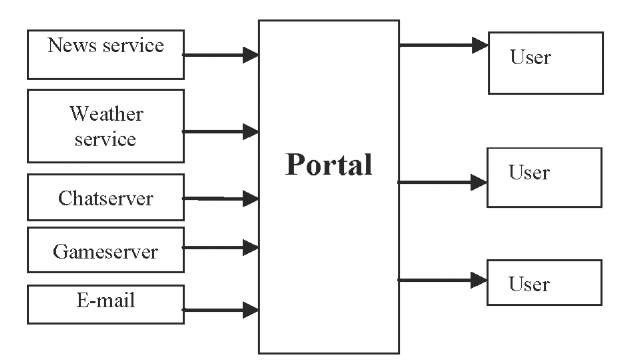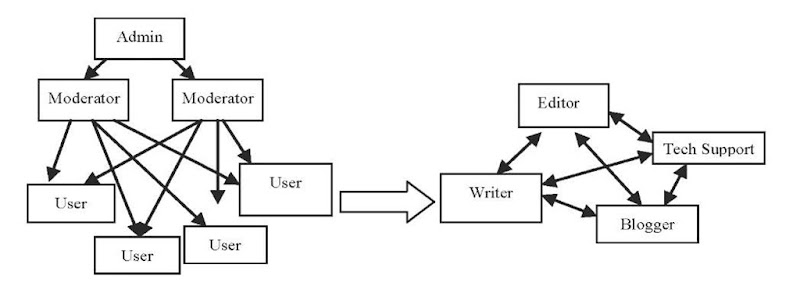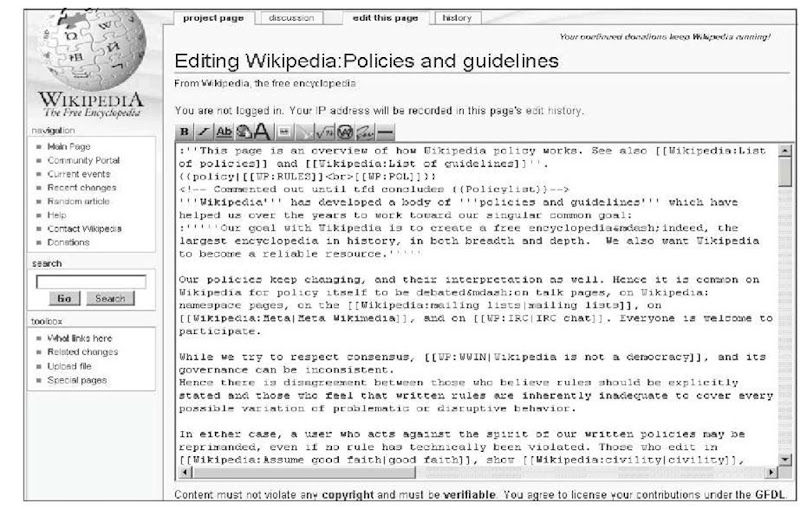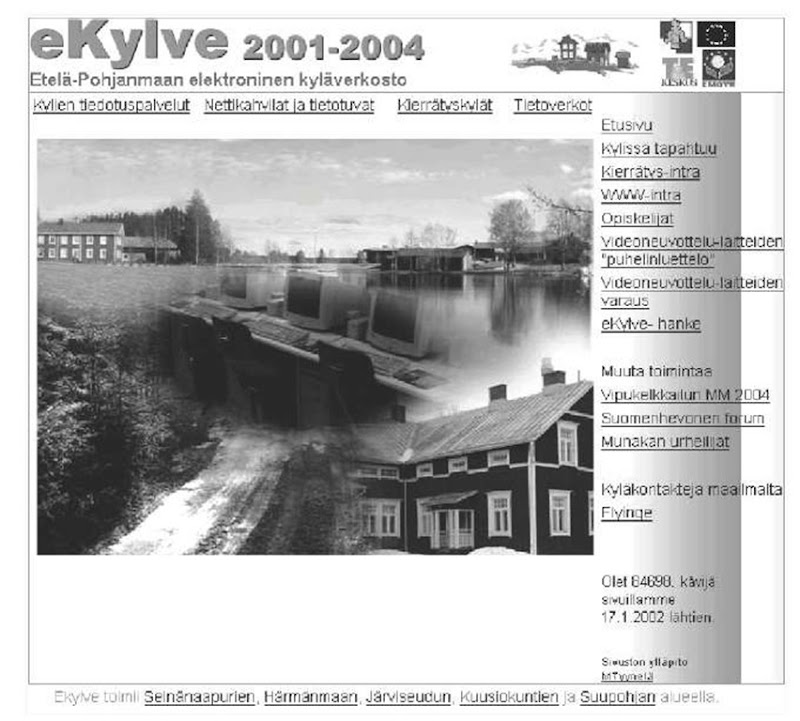INTRODUCTION
Information content of the Web has, in the last 10 years, changed from informative to communicative. Web pages, especially homepages, were the foremost places where companies, organizations, and individuals alike expressed their existence online and provided some information about themselves, like their products, services, or artefacts that they related to. On the common Web environment, the search engines were harvesting this information and made it available and meaningful for the masses of Web users. In the early days of Web, this factor alone justified the usage of Web as a marketing tool and as an easy way to share important information between collaborating partners.
BACKGROUND
In more recent years, the evolving Web technology has spawned more interactive and fine-grained approaches and tools for using the Web. Examples of these have been features like online quizzes and games, for example, contained on the Web pages. Even here, Web users are mainly information consumers, and their actions and opinions are stored in the underlying databases behind the Web-based information systems and applications. The strong growth of peer-to-peer type Web activities has emphasized the key role of users as information producers also (Aigrain, 2003).
Also, the real-time connectivity and other shared information aspects, like time, space, price, availability, and “rumours,” have accelerated both the information production and consumptions processes in the Web. The different home multimedia applications, like radio, digital TV, and others, are also heavily using the Web for providing two-way user interaction and feedback into the main streams of communication. Finally, even automated information production, like Web cameras, online weather stations, satellite images, maps, home, and industry automation systems and devices, often are Web enabled in their presentation options.
COMMUNITY PORTALS Personal Portals
Web portals are sites on the World Wide Web that provide a number of services to their registered users. The services can often be personalized by the users and implement distributed applications in order to bring together a wide variety of services under a single Web address. Portals are often designed to be places where the user will return as often as possible, perhaps even make it their starting page on their browsers.
In order to entice the users to return time after time, portals provide services that the user will want to use daily. Services such as Web searches, e-mail, news, games, TV-listings, and so forth, are common. In order to provide revenue, advertising and shopping are common features in commercial Web portals. On the other hand, government portals gather various pieces of information on one site (Gronlund & Albinsson, 2000). These are formed to help the citizens to find what they need more easily, as well as submit various forms.
Many Web portals grew from single services, such as Web directories, news services, or search sites. Commercial portals needed something to keep their users interested in order to keep the user in the portal for a longer period of time and thus, to increase advertising revenues, so new services were adopted. Most of these services were already proven to be popular and easy to implement. Commercial portals, as well as other actors on the Internet, like Google, are attempting to become as ubiquitous as possible and thus, improve their share of the valuable market.
Figure 1. Portals provide different services to different users
Many companies also provide portals for their different stakeholders. These are often referred to as B2C (business to consumer), B2D (business to distributor), B2E (business to employee), B2B (business to business), B2G (business to government), or similar names. In large organizations, the B2E portals are the most important and varied. They provide a place where the employees can find any piece of information they might need. They also function as groupware, where the employees can cooperate, publish documents within the organization, and so forth. For the other stakeholders, the portals can provide personalized content and services, integration with their own systems and information. Ideally, these portals would provide a number of Web services for the stakeholders that would facilitate for automatic processes between two organizations. This would be especially useful for businesses on government portals, so that reporting revenues and such would be as easy as possible.
Portals for Communities
Community portals are portals provided for a community of people with a similar interest. Community portals can be regional (see eKylve), occupational (auditnet.org for professional auditors), or simply places for hobbyists to gather (TheRPGPortal.com for role-playing gamers), among other things. Community portals are also an excellent way for people working or studying abroad to keep in touch with their native culture. Community portals can provide the members with information, shopping, and so forth, but also the feeling of social community. In community portals, the social side is very pronounced. Because of this, information is often dispersed in the form of stories rather than facts. Users of community portals may develop strong bonds with the other users, despite never having met and possible vast geographical division.
The success factors of online communities have not been studied well. Jenny Preece has developed a method that can be used to verify usability and functionality of the platform, software used by the online communities in their activities. Simultaneously, she has traced definitions and gauges of the success factors of the online communities. For this purpose, an end-user based set of gauges has been developed that is used to clarify the factors of interactive, real-time software solutions in relation to their uses.
According to Preece (1994, 2000), the success factors can be divided by the factors supporting sociability and usability. Sociability factors are divided by the significance of the software for its end-users, the population and the special needs of the end-users, and the procedures used in the sessions. The usability factors are divided by the time needed to learn dialog and the interaction, how long it takes to learn to use the user information (help-section of the program), the internal navigation of software, and its factors. Finally, whether the users are able to find all the needed components of the software must be explored. With all the mentioned factors in mind, the time and the steps the user takes while fulfilling a task are studied.
As the software is more and more standard in form and look, most users find it easy enough to adapt into a certain application on the Web. Therefore, usability is not as big an issue as the social side of the current online communities. Sociability is measured by mean of use, people, and the procedures. Mean of use is based on the number and quality of the messages and comments sent. Importance is placed on the accuracy of the discussion and the nature of interaction between the members. The number of people is important, but also their roles and experience. Age, sex, and special needs are also factors. Procedures define the rules of conduct, organization of the community, joining the community, and possible repercussions of breaking the rules. Procedures can also encourage sociability and improve creativity.
Figure 2. The organizations of Web communities are moving from hierarchical to networks
For sociability, real-time interaction can be very beneficial. On the other hand, members of a community, who are unable to participate in the discussions at the times when activity is high, will feel isolated and will not grow into a strong member of the group. Therefore, other methods of communication are also important. Members should be allowed to grow into different roles within the community. Some will be better at content creation, whereas others are better editors or can provide technical expertise. All communities need members in each role and others too, depending on the nature of the community and the portal.
In order for the community to function and grow, users must feel welcome, and even though the community is not necessarily familiar, it should feel friendly. In many cases this is not true. New members of an online community may be ridiculed and they could face opposition. However, this is akin to hazing in many communities in the real world. Those who prevail will become accepted members of the community, those who do not can seek out more friendly sites. These communities are often small but strong, since the members feel that they have earned their right to be a part of the group. This kind of gang mentality is often frowned upon even by the group themselves, but no actions are ever taken against it.
With continually improving free software, implementing and using a community portal is becoming simpler. Content management systems are critical. In order for a community portal to work, it must be simple enough for the users to find intuitive. This includes easy installation through simple Web-based interfaces, easy updates of the software, easy management of content, and easy interface as well as navigation for the visitors. Because current technology supports multimedia, content should not be restricted to text. With cameras in many cell phones, situations are often easily recorded and shared with a community through pictures. Also, sound and video are easy to record and distribute digitally, so communities should use them, if possible, depending on the nature of the community.
The role of users is in key focus on present Web pages and portals. The earlier Web communities that were closed, usually by user registration and moderation of the information presented, have recently become more open and open minded, as the regular users are also heavily involved in the content generation themselves. Earlier, the communities were built around a few experts on the subject at hand who also happened to have some technical expertise. The communities were also often technically inclined, as the amount of technical knowledge needed was too sizable for most people to comprehend. Most users were able to take part in discussions, but their input on the actual content was low. The open approach for information usage originally started with mailing lists and discussion groups, and the spread and volume of communication and the stronger, active relation between the participating people in the discussions has recently turned into Weblogs or blogs. Blogs are written independently or by small groups of people, but they are often connected to other blogs through friend networks or backtracks, which can be used to notify owners of other blogs that their blog has been referred to.
Figure 3. An example of Wikipedia merchandise giving a humorous example of the Wiki-philosophy
Figure 4. Editing a page in Wikipedia
The most impressive of the open Web communication examples is the open software production communities, their software exchange site, SourceForge, being the most populated and active Web community portal. The different domain specific information gathering and sharing communities, like open directories such as Dmoz or Yahoo, or user communitie s that exist for different intere st groups such as the blind and the deaf, both in their international and localized communities, can help members find specialized information quickly. Ultimately, the Wikipedia provides general information, even in several languages, in an encyclopaedic manner. Wikipedia has also been integral in popularizing its underlying wiki wiki technology, which has become commonplace. Many open source projects use wiki wiki sites for documentation (e.g., Moodle, Mozilla) and many discussion forums have been replaced by wiki wikis. Wiki wikis have evenbeen implemented as a platform for collaborative fiction projects. Whereas Wikipedia has somewhat strict policies on editing and behaviour, also making it clear that it is not a democracy, Anarchopedia goes further. Anarchopedia has no central control; everything is moderated by the users themselves, who are all considered equal. The site in itself is a social experiment in anarchy.
There are quite big negative issues related to online communities, however. The most discussed examples are child pornography exploitation rings and many violent personal and social physical and nonphysical attacks towards people and organizations by people who have met or are supported by some online communities. Here the same self-awareness of the portal and its users acts like an amplifier of their negative feelings and dislikes towards real and imagined opponents. Especially children are very vulnerable to these kind of threats and channels due to their childish curiousness and open-mindedness towards all aspects of human life and society. Many regular users are disenchanted by the communities because of so-called “flame wars,” or a new breed of users who have not yet learned the netiquette. The incursion of younger users is commonplace, as computers are becoming more widespread and the user interfaces are becoming simpler and available in practically any language.
In e-commerce and for companies, the main abuses have been on their customer relations, where people’s credit and bank accounts have been misused or have not been properly secured and thus have fallen into the wrong hands. Also the quality, availability, and usability of both physical artefacts and nonphysical objects, like software, have been attached by intervening hackers, malicious programs like viruses, or bogus information in several formats and forms, like phishing for the user’s information like passwords, or even online harassing for the whole personality or life style. Recently, the company and organization reputations have been under heavy attacks by critical comments about their external or internal business approaches and processes, whose sustainability, moral, or ethics have been openly questioned and criticized in various online communities.
The trend here seems to be that the information spreads very quickly, even internationally, and often through unofficial, personal links and connections due to the active role of people as new, intermediating sources of information. Communities are an important factor in this. Users will gravitate towards others who have similarviews and interests. News travels even faster among those who take an active interest in the subject. Also, open source mentality has resulted in the creation of Creative Commons licensing, which has enabled individuals and groups to use and spread information without the fear of losing their rights on the materials. The fact that information can be duplicated practically, without cost, makes distributing it much more viable than distributing physical goods. The example of Star Wreck: In the Pirkinning (http://starwreck.com), with approximately four million downloads has shown that digital content can be easily distributed over the net. It has reached more people than any other Finnish movie, commercial or otherwise. After the wide and technical overview of community portals and their present development we presented, we will next give a practical example of an existing regional online community.
eKylve
Electronic Village Network (Finnish abbreviation eKylve) project in Etela-Pohjanmaa, western Finland was one of the first serious attempts to remove the paradigm of the digital divide phenomenon in the rural areas (Castells & Himanen, 2002). In a 3-year period, the EU-financed project included 22 participating rural villages. Its aim was to fight the unequal division of digital services in the nonurban areas (Digital Divide, 2007). The main idea was to make computers available with legal software, fast Internet connections, and the skills needed to use the both for the villagers, then to have own villages Internet-based local information platform, which we call “Villageware,” “Inter-village” -service and lastly, to create the fully empowered online communities for different purposes.
Figure 5. The main page of eKylve
The digital divide phenomenon is the result of diminishing population of rural areas, which has lead to deterioration of traditional services and slow development of new ones. The information highway is expected to at least partially remove this problem. New possibilities of commuting, virtual learning, and e-commerce are giving hope of survival for the rural lifestyle chosen by some. The main problem is the lack of willingness to learn and adopt the new technologies.
The new technology can also help the local community to survive. Many of the small villages have lost all local services, including village schools, and so forth. As such, the villages are losing their identity as well. However, the local school buildings have, in some cases, been transformed into village centres known as village houses. To facilitate this development, a network of villages was created, where Internet-based local activities act as a backbone for all other activities. In eKylve, the network was created by the villagers themselves.
Each village has its own independent groupware on the common Linux Web server. This server was originally maintained professionally, but was moved into one of the participating village houses. The software was maintained after the move by experts from the participating villages. This group formed a community of 14 people, who had a special interest in ICT and Web applications. This group consisted of five women and nine men, with an even age distribution with minimum of 21 and maximum of 72 years. They represented 10 of the 22 villages and were all within 100 kilometres from the regional centre of Seinajoki where training was arranged. In practice, most of the community participated in the training sessions directly from their homes through videoconferencing. Due to the long distances, virtual learning proved to be invaluable. Some of the participants made some minor investments in hardware to be able to take part in the classes. Although the main focus of the training was the technical aspects of maintenance, the training also had the purpose of forming a team that would enhance the problem solving within the group. For this reason, all the participants were online at set times, although the virtual learning material was available at all times.
In the early phase, the informality and distributed nature of the expertise was confusing or even scary to some of the participants. Some found it disturbing that a set of unknown people were also participating in the same group. This was,in some cases, an even bigger obstacle than the technology involved. However, about half of the group interacted directly with all the other members of the group at some point. Also, about half had discussed with family members or acquaintances outside of the software environment. Technical issues seemed to prevent some of the interaction between some members, but shyness was also a factor in one case. Previous familiarity and being able to see the other party were factors that seemed to make discussions easier.
Figure 6. The changing role of the community portal
After the project, the online community partially fell down, but some of its members still continue to use and develop the ultralocal services. Some of the members of the community also participated in the creation of regional computer networking cooperatives in order to enable fast Internet connections in their region.
FUTURE TRENDS
The communicative portals have become virtual places and hubs for real people in their daily life and communication. The amazing aspect of the modern communicative portals is that they seem to be largely in their information value self-aware, self-correcting, self-controlled, and auto-monitored, as the active information producers and consumers personally enhance, correct, and improve the information nuggets in a way that was nonexistent and impossible with the traditional media. It seems that people feel that they own and appreciate this information, at least virtually, so much so that they are willing to interact with the information in a two-fold way, devoting a lot of their personal expertise, effort, and time. The personal benefit they obtain is a new social network, self-esteem, and a live community, where they can get feedback, support, and trust for further improvement oftheir own knowledge via community acts. These new social networks also enhance and replace the restrictions of their personal and physical lives in a way that has never been seen before. Web, which was considered socially restrictive for young people especially, is suddenly making the people both aware and social in a very intensive and multinetworked manner. All-in-all, the Web is evolving towards the original vision of Berners-Lee, in which the Web users are responsible for the content as a collective, rather than individuals, perhaps even adopting WYSIWYG-style interfaces in the future.
As the platforms are becoming more diverse, portals are going to need to be able to answer to different expectations of the users. The portals should be able to automatically adjust themselves to the needs of the mobile users, for example PDAs and cell phones. Mobility will lead to a need for context-aware content. Especially localized information will be of special interest. This means that many communities will need to be able to find enough contributors for the portals from a vast and possibly very diverse area.
CONCLUSION
Public opinion has found its way to our everyday life. All actors have to take this into account and provide new, organized, and democratic ways of sharing the information, unless they want to face the increasing anarchic and attacking “information bombs” by the self-aware and awake communities of Web users. Users must be increasingly aware of the Web content in order to be able to filter the information that is usable. Mutual trust within a community is very important for the existence of a community portal.
KEY TERMS
Blog: Short form of Weblog. Blogs are Web sites in which an author or authors can make their opinions public and receive comments on them. Blogs are updated regularly, include simple a CMS as well as user administration and are often dedicated to a specific subject, for example information security issues, movies or stock market.
Community Portal: Web portals designed for an online community.
Content Management System or CMS: CMS is a system for managing Web sites and Web content.
Creative Commons License: Creative Commons is an organization that provides several licenses that can be used freely. The basis of those licences is to share information without some of the restrictions of current copyright laws. The copyright owner can still retain rights to their works.
Distributed Application: An application created from several distinct components that are connected via a network often using middleware.
Online Community: Online community is a group of people who primarily interact through technical means rather than personally. Also known as virtual communities or mediated communities.
Web Content: That which is contained by a Web site; materials that are designed to encourage visits to a Web page.
Web Portal: A site on the World Wide Web that implements distributed applications to provide their registered users with a variety of services in order to encourage visits.






